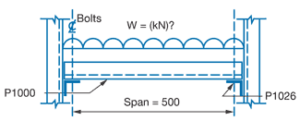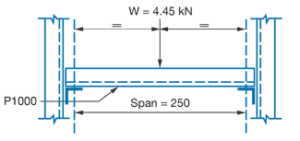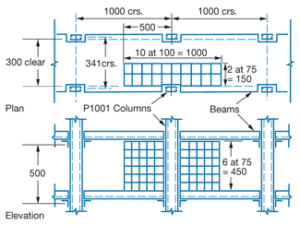The load capacity of Unistrut members acting as a horizontal beam, between two vertical Unistrut members acting as columns, is governed by:
If items a), b) and c) are known, the load capacity is the smallest value of d), e), and f) as read or derived from the listed values in the appropriate tables.
What is the uniformly distributed load capacity of a P1000 section used as a beam to span 500mm if P1026 connectors are used to support the beam?

A beam of 250mm span is to carry a central point load of 4.45kN. Check if P1000 section is a satisfactory

As this is the value for the equivalent uniformly applied load a correction is necessary to account for a central point load. This is done by multiplying the uniform load deflection by 0.8 (see Notes to Tables).
Hence deflection under applied point load:
= 0.10 x 0.8 = 0.08mm.
The load capacity of Unistrut Sections acting as columns depends on:
If a) and b) are known and if c) and d), for the case being considered, match the conditions in Structural Data Notes then the load capacity of the section can be read directly from the tables under “maximum column load”.
It is emphasised that, for tabulated values to be used directly, the resultant load must be concentric (i.e. act through the C.G.) and connections at each end of a free column height must restrain those ends from both horizontal and torsional movement.
If these conditions do not apply, reference should be made to the appropriate sections of AS/NZS 4600 since it is most likely that a smaller value than the listed one should be used.
Island-type storage shelving is to be constructed using P1001 main posts (columns) at 1000 x 341mm centres. Shelves are to be at 500mm vertical spacing starting from the floor and connected to the posts so that concentric loading and translational and torsional restraint are provided at each level under full load conditions.
If the shelves are to carry packages of bolts stacked six high per shelf and the packages measure 75 x 75 x 100mm with a mass of 6.5kg each, what is the maximum height (number) of shelving that can be used?

Hence maximum number of shelves = 12
i.e. max. height of shelving = 12 x 0.5 = 6.0 metres.
Note: If the bottoms of the columns bear onto P1000 bearers, which in turn are fixed to the ground, the load capacity of the column would be determined by the Recommended Bearing Load, (refer to Safe Bearing Loads in this Tab Section) of 30.3 kN. The number of shelves would then be given by: 30.3/7.64 = 3.96
i.e. 3 shelves, totalling 1.5 metres high.